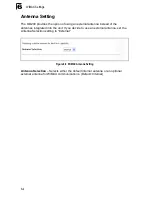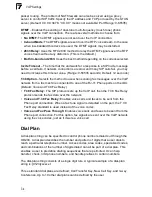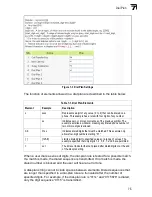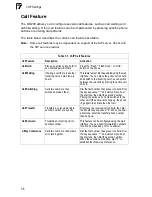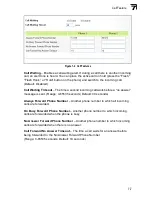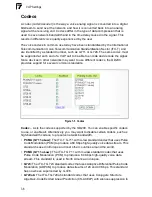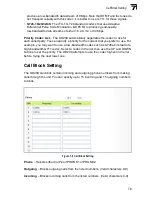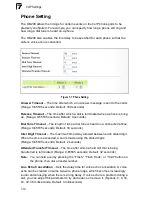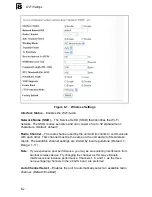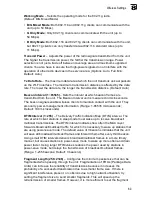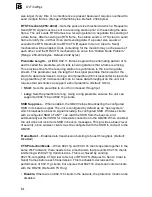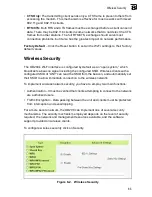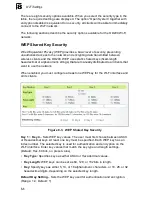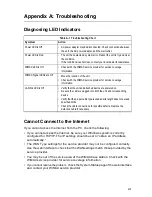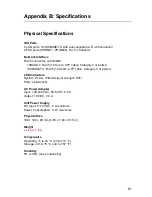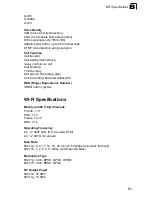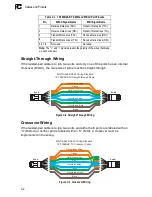
Wireless Settings
8-3
8
Working Mode
– Selects the operating mode for the 802.11g radio.
(Default: B/G Mixed Mode)
•
B/G Mixed Mode:
Both 802.11b and 802.11g clients can communicate with the
unit (up to 54 Mbps).
•
G Only Mode:
Only 802.11g clients can communicate with the unit (up to
54 Mbps).
•
B Only Mode:
Both 802.11b and 802.11g clients can communicate with the unit,
but 802.11g clients can only transfer data at 802.11b standard rates (up to
11 Mbps).
Transmit Power
– Adjusts the power of the radio signals transmitted from the unit.
The higher the transmission power, the farther the transmission range. Power
selection is not just a trade off between coverage area and maximum supported
clients. You also have to ensure that high-power signals do not interfere with the
operation of other radio devices in the service area. (Options: Auto, Full, Min;
Default: Auto)
Tx Data Rate
– The maximum data rate at which the unit transmits unicast packets
on the Wi-Fi interface. The maximum transmission distance is affected by the data
rate. The lower the data rate, the longer the transmission distance. (Default: Auto)
Beacon Interval (1~65535)
– Sets the interval at which beacon frames are
transmitted from the unit. The Beacon Interval unit is measured in microseconds.
The beacon signals enable wireless clients to maintain contact with the unit. They
also carry power-management information. (Range: 1-65535 microseconds;
Default: 100 microseconds)
DTIM Interval (1~255)
– The Delivery Traffic Indication Map (DTIM) interval. The
rate at which client stations in sleep mode must wake up to receive broadcast/
multicast transmissions. The DTIM interval indicates how often the MAC layer
forwards broadcast/multicast traffic, for which it is necessary to wake up stations that
are using power-save mode. The default value of 3 beacons indicates that the unit
will save all broadcast/multicast frames and forward them after every third beacon.
Using small DTIM intervals delivers broadcast/multicast frames in a more timely
manner, but causes stations in power-save mode to wake up more often and drain
power faster. Using larger DTIM values reduces the power used by stations in
power-save mode, but delays the transmission of broadcast/multicast frames.
(Range: 1-255 beacons; Default: 3 beacons)
Fragment Length (256~2346)
– Configures the minimum packet size that can be
fragmented when passing through the unit. Fragmentation of PDUs (Package Data
Units) can increase the reliability of transmissions because it increases the
probability of a successful transmission due to a smaller frame size. If there is
significant interference present, or collisions due to high network utilization, try
setting the fragment size to send smaller fragments. This will speed up the
retransmission of smaller frames. However, it is more efficient to set the fragment
Summary of Contents for Edge-Core OD200
Page 1: ...Powered by Accton www edge core com User Guide OD200 Outdoor WiMAX Residential Gateway...
Page 2: ......
Page 4: ...OD200 E032008 CS R01 1...
Page 8: ...iv...
Page 12: ...viii Table of Contents Glossary Index...
Page 16: ...Figures xii...
Page 26: ...Introduction 1 10 1...
Page 36: ...2 10 Installing the OD200 2...
Page 58: ...System Settings 4 10 4...
Page 98: ...Wi Fi Settings 8 10 8...
Page 108: ...Cables and Pinouts C 4 C...
Page 118: ...Glossary Glossary 4...
Page 122: ...Index 4 Index...
Page 123: ......
Page 124: ...OD200 E032008 CS R01 1...


